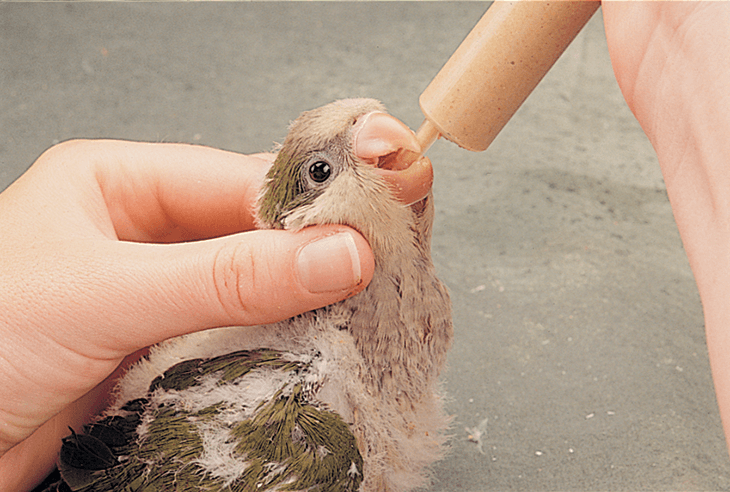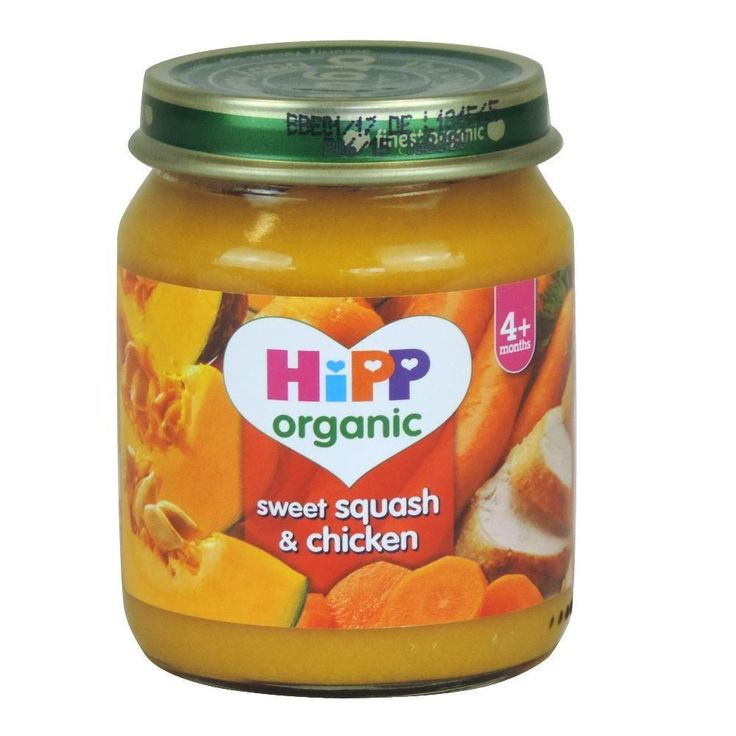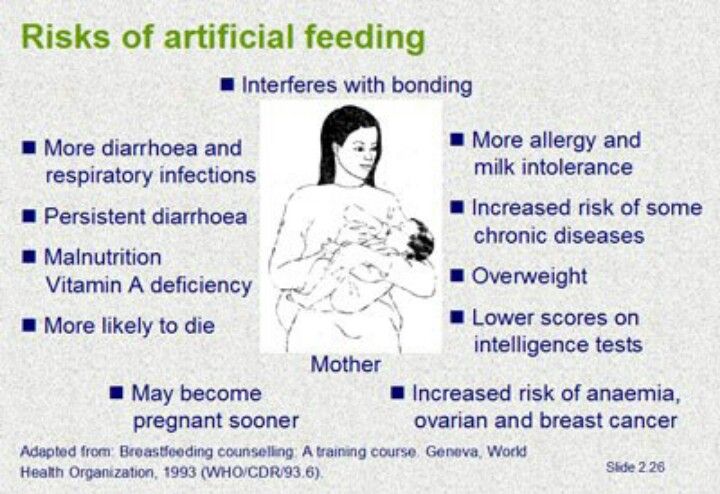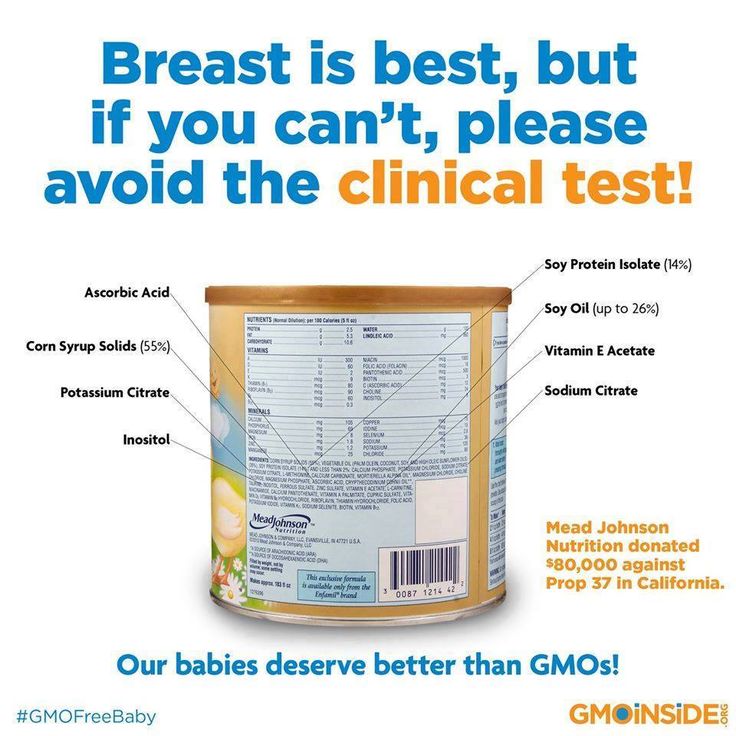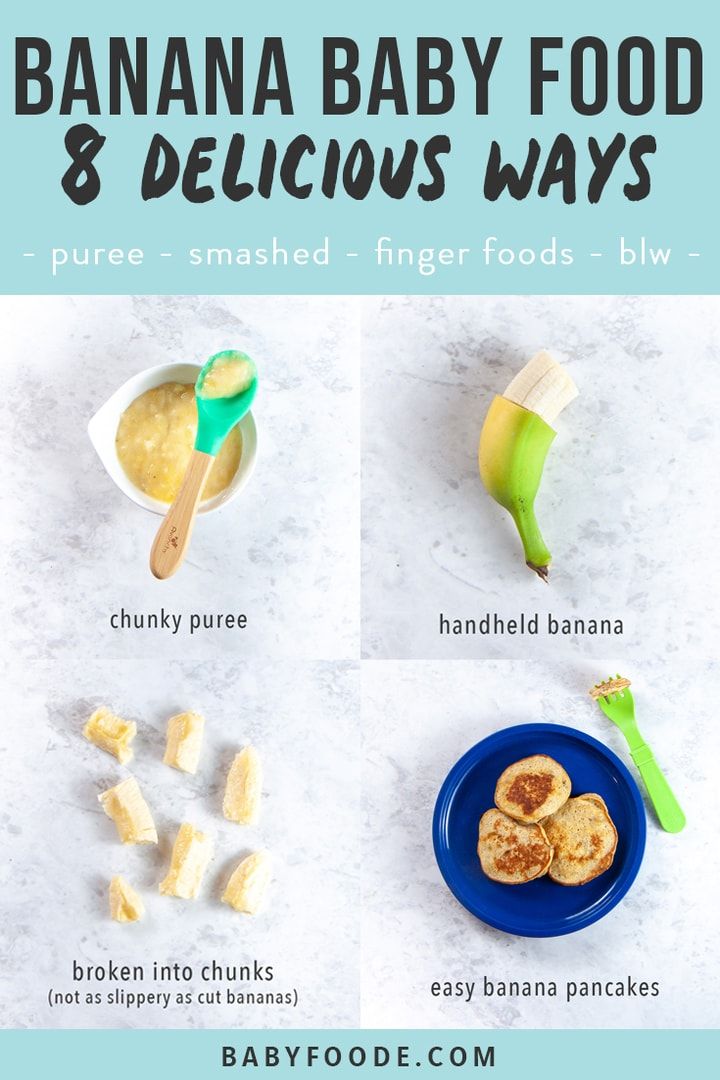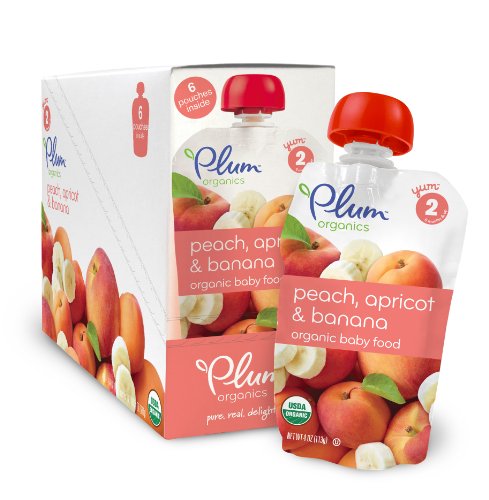How to feed a baby cockatiel bird
Protocols for the hand-raising and care of cockatiels (Nymphicus hollandicus)
Corina Gardner
Introduction
Cockatiels (Nymphicus hollandicus) are native to Australia and were first identified in the mid 1700’s. It is unclear when they were first imported out of Australia, but they were found in Europe in the 1800’s and have been exported to all parts of the world in the last few decades. They have been bred in captivity for over a hundred years now.
Cockatiels are intelligent, gentle and playful birds. They are usually very inquisitive and will thoroughly investigate anything everything that is around them. Individual cockatiels have very distinct personalities, behavior traits, and their own likes and dislikes. For example, grinding its beak indicates that the bird is sleepy and relaxed. These gregarious birds make one of the most popular pet birds today.
Cockatiels are naturally sociable birds and enjoy human contact. Hand-reared cockatiels are particularly easy to tame. Even cockatiels which have not really had very much human interaction but have been introduced into the company of humans adjust very well. Our cockatiels greet us when we get home by whistling and calling out. Most pet cockatiels even enjoy eating when their owners are having their meals. They crave attention and have a distinct call when they don’t want you to walk away from them. They can sometimes be incorrigible. If they are aware that they a particular behavior will annoy you, then that’s precisely what they will do.
General Guidelines for hand-rearing baby cockatiels
Often, young and inexperienced parents may abandon their nests and refuse to feed baby birds. Such a situation would demand immediate intervention and you will have to care for the baby birds yourself. If there happens to be another pair of cockatiels with a brood of chicks of a similar age, then chances are that the parents may accept and care for the abandoned chicks. Regrettably, this is seldom the case.
Regrettably, this is seldom the case.
Hand-rearing a baby cockatiel is an extremely challenging and time consuming task that requires absolute dedication and patience. Baby cockatiels, which are also commonly called pinkies, are extremely delicate and fragile and therefore require immense amount of diligence while handling. As this is the most vulnerable part of their lives, special care must be taken to ensure the survival of these baby birds.
Feeding and hygiene
A disposable syringe, which is easily available in most medical stores, can be used for feeding the young birds. If unavailable, then the next best alternative would be to use an eye dropper or a plastic teaspoon. The slender tip of the spoon can be dipped in boiling water and then bent make a funnel, thus making it easy to use for hand feeding.
After feeding, the feeder (spoon, syringe or dropper) must be rinsed with warm water to remove any bacteria. Mild soap or detergent can be used to clean the feeder; however, it must be washed thoroughly so that no soap residue remains.
Baby bird formulae, for example, Kaytee Exact, available in most pet stores would be an ideal feed. However, as it is not easily available in India, baby formula like Cerelac can be used instead. If however neither of these is available, then a piece of bread can be crumbled in lukewarm milk and fed to the young birds - but I would only use this as a last resort. The formula must be prepared in a glass container as plastic containers tend to harbor bacteria. The consistency of the formula should be similar to that of a soft pudding – neither too thick, which would make it difficult for the baby to swallow and it may choke, nor too diluted as the baby could inhale the formula into its lungs causing aspiration. The formula must only be heated adequately before feeding the baby. Formula that is too hot will scald the baby bird’s crop, causing crop burn. Crop burn is the scalding of a chick’s crop and esophagus. For the same reason, formula must never be heated in a microwave. On the other hand, formula that is cold will cause sour crop. Sour crop is a condition in which the formula in the baby’s crop has gone bad and the contents of the crop has not emptied.
Sour crop is a condition in which the formula in the baby’s crop has gone bad and the contents of the crop has not emptied.
The baby bird can be placed on a napkin or towel on a table or kitchen counter and held gently while feeding. The aim is to emulate the parent bird as much as possible. Parent birds tap on the baby bird’s beak to stimulate the feeding response. So, gently tap the bay bird’s beak with the feeding instrument in a similar manner to encourage the feeding response. The feeding response is when the baby gapes for food, bobbing its head up and down. Parent birds then feed their chicks by inserting their beaks at an angle, through the side of the baby’s mouth. They then regurgitate the food deep into the baby bird’s mouth. Therefore, insert the tip of the feeding syringe at an angle at either sides of the baby’s beak. Press the plunger slowly, stopping every now and then, so as to allow the baby time to swallow. The speed of feeding must never be hastened. Enough time must be allowed for the baby to swallow its food before pressing on the plunger any further. Once its crop is full, not over-extended, and it has had enough to eat, the baby will stop gaping and refuse to open its beak. Feeding must be stopped immediately. Over feeding can cause formula to flow into the throat and down its windpipe, which can be life threatening. The baby must not be forced to feed when it is reluctant to accept food. The beak and feathers of the baby must be wiped gently with a warm, damp cloth after feeding.
Once its crop is full, not over-extended, and it has had enough to eat, the baby will stop gaping and refuse to open its beak. Feeding must be stopped immediately. Over feeding can cause formula to flow into the throat and down its windpipe, which can be life threatening. The baby must not be forced to feed when it is reluctant to accept food. The beak and feathers of the baby must be wiped gently with a warm, damp cloth after feeding.
1-7 day old baby
New born cockatiels are born totally helpless, eyes closed, pink with a few downy feathers.
Ideally, feeding should start at 6 a.m. and continue until midnight. The baby should be fed every 2 hours. A day old chick would require approx 1 ml of formula per feed, which can be gradually increased to 2 ml by the 4th day and 3 ml by 7th day. It is unnecessary to give the baby any additional water as they receive sufficient fluids in their feed itself. It is unnecessary to feed the baby at night as in nature, parent birds as well as their babies sleep at night.
2-3 weeks
Pin feathers begin to erupt in the second week of the baby’s life & the eyes usually open around the 8th -10th day.
The baby can be fed every 3 hours. The feed quantity must be increased to 4-5 ml per feed. Feeding must still begin by 6 a.m., however, the last feed could be given by 10 p.m.
3-4 weeks
The baby still has a few pin feathers.
The formula should now be of a thicker consistency and the feed quantity can be increased to 6 ml per feed. The frequency of feeding can be decreased to a feed every 4-5 hrs. The baby’s crop usually empties within 4 hrs. A crop that remains full or does not empty completely within that time indicates that there is a problem. The crop is a muscular pouch near the throat of the baby bird that is used to store excess food for subsequent digestion.
4-5 weeks
The baby birds start to develop flight feathers by this age and are now called fledglings. They also start foraging (searching for food) themselves by this age. Feed quantity can now be increased to 8 ml per feed and the frequency of feeds can be decreased to 2-3 feeds a day. The weaning process must begin by the time the baby is 5 weeks old.
Feed quantity can now be increased to 8 ml per feed and the frequency of feeds can be decreased to 2-3 feeds a day. The weaning process must begin by the time the baby is 5 weeks old.
Weaning foods such as greens, bits of toast and bread, crushed and grated boiled eggs (along with the shell) and cream cracker biscuits can now be offered to the young birds. This mixture is an easily digestible substitute and ideal during rearing of young birds. Mixed bird seeds such as millet (durra), foxtail millet (kheri), finger millet (ragi), sunflower seed, etc. should also be given to the birds.
6-7 weeks
The young bird is quite independent now and it’s time to transfer the bird to a cage. Although they feed well by themselves at this age, they must be watched vigilantly to ensure they are eating well. If necessary, feedings can be continued once or twice a day.
Mixed bird seed, which is available in most pet stores, should also be given to the bird. In the event that bird seed is unavailable then large millet seed (bajra), finger millet (ragi), foxtail millet (kheri), sunflower seed (suraj mukhi), safflower (beni or kardi) seed, pumpkin (kaddu) seed, boiled maize (makki) and soaked gram (chana) can be provided. It’s always advisable to offer the young birds entire or un-hulled seeds as hulled seeds tend to decay and mold. Seeding grass, French beans, and carrots are always a welcome treat as well. Green leafy vegetables such as lettuce, mustard sprouts, millet sprouts and fenugreek (methi) leaves is essential along with other weaning foods. By 8 weeks of age, the bird should be completely weaned.
It’s always advisable to offer the young birds entire or un-hulled seeds as hulled seeds tend to decay and mold. Seeding grass, French beans, and carrots are always a welcome treat as well. Green leafy vegetables such as lettuce, mustard sprouts, millet sprouts and fenugreek (methi) leaves is essential along with other weaning foods. By 8 weeks of age, the bird should be completely weaned.
Foods that are toxic for cockatiels include apple pips, avocado (makhanphal), cherries and peaches (aadu). Never give your birds chocolate, as it may make your bird seriously ill.
In the event that the bird suffers an upset stomach or diarrhea, indications of which include watery green droppings, a pinch of Ridol or Kaltin or any other binding tablet can be crushed and mixed in a half container of water and offered instead of plain drinking water.
Grit, which is a mixture of sand and stones, and cuttle-bone, which is rich in calcium and phosphates, should be given to the birds periodically. Clean, fresh drinking water must be provided daily. The feed and water containers must never be placed directly beneath perches as the bird’s dropping will foul the contents.
Clean, fresh drinking water must be provided daily. The feed and water containers must never be placed directly beneath perches as the bird’s dropping will foul the contents.
It’s also a good practice to provide a shallow dish for the birds to bathe in. Another option would be to use a spray mister (plant atomizer mister), filled with warm water, not hot water. Many a time you’ll find your bird flapping its wings and hanging upside down from its perch, this usually indicates that the bird wishes to bathe. You will know that he is enjoying his bath when he puffs out his feathers, raises both his wings up and away from his side and leans forward.
Housing the young birds
A shoe-box or small cardboard box with adequate holes for ventilation, a wicker basket or even a small aquarium may be used to house the young birds. The box can be lined with a soft towel at the base and a few layers of tissue papers on top of the towel, making it easy to change the paper towels when dirty. The box must be placed in a warm, dry place, preferably near a source of warmth. A heating lamp, with a light bulb of maximum 40 watts, can be placed above the box. The lamp must be placed at least 12” away from the box. The ideal temperature for the baby birds would be about 35.5° Celsius (or 96° Fahrenheit). Again, it is crucial to be vigilant and ensure that the baby is not being overheated. A clear indication of overheating would be when the baby’s beak is open (as if panting) and wings are held away from its body. On the other hand, if it’s huddled and shivering, it is not receiving enough warmth. At night, partly cover the box with a light towel to keep out the light from the heating lamp and thus enable the baby to sleep.
The box must be placed in a warm, dry place, preferably near a source of warmth. A heating lamp, with a light bulb of maximum 40 watts, can be placed above the box. The lamp must be placed at least 12” away from the box. The ideal temperature for the baby birds would be about 35.5° Celsius (or 96° Fahrenheit). Again, it is crucial to be vigilant and ensure that the baby is not being overheated. A clear indication of overheating would be when the baby’s beak is open (as if panting) and wings are held away from its body. On the other hand, if it’s huddled and shivering, it is not receiving enough warmth. At night, partly cover the box with a light towel to keep out the light from the heating lamp and thus enable the baby to sleep.
It must be noted that the purpose of the lamp is to provide warmth alone, and not light, and it must never interfere with the natural light patterns and disrupt the baby bird’s sleep cycle. In nature, cockatiels nest in hollow tree trunks in wooded areas, where not much light enters.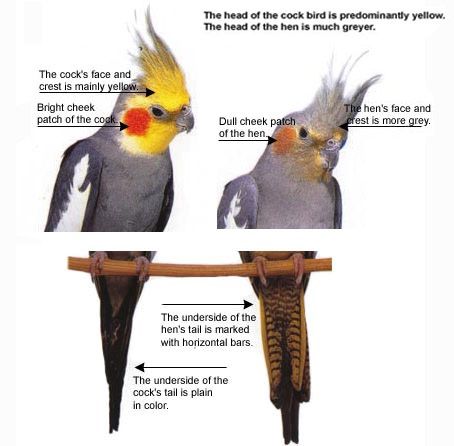 Even when in captivity, the parent bird sits on the baby, shielding it from most of the light. The heating lamp may be discontinued after the baby crosses 2-3 weeks of age and is covered with its first layer of feathers.
Even when in captivity, the parent bird sits on the baby, shielding it from most of the light. The heating lamp may be discontinued after the baby crosses 2-3 weeks of age and is covered with its first layer of feathers.
Ants are a real danger to baby birds and can fatally hurt them. It must be ensured that there are no ants in the vicinity of the bird.
Once shifted to a cage, it must be ensured that the cages are spacious enough to allow free movement between perches. Perches should be placed just above the floor of the cage so that the bird can easily climb onto them. The cage must be located in a well lighted location with a source of natural light such as sunlight. Avoid exposing the birds to a cold breeze or draught, especially at night, as this causes chills and other health problems.
Fresh, natural branches of Indian lilac or neem (Azadirachta indica)and other trees should be provided as perches as this helps to keep the feet and claws of the birds healthy and strong. It not only strengthens their jaws and sharpens their beaks but keeps them occupied as well. Birds are otherwise prone to boredom and feather plucking.
It not only strengthens their jaws and sharpens their beaks but keeps them occupied as well. Birds are otherwise prone to boredom and feather plucking.
It’s advisable to cover the cage with a cloth at night as it gives the bird a feeling of security. If you get too near the cage at night, you might find him hissing. This is a fine demonstration of his protest to your invading his personal space and literally translates as, “don’t get in my face”. Beak-banging is a common male cockatiel trait that indicates he is looking for attention.
Clipping toenails
In the wild, birds’ nails are naturally smoothened out on a range of surfaces but this may not the case in captivity. However, if it transpires that your bird’s nails have grown too long then clipping them becomes inevitable.
Overgrown toenails are likely to get caught on a perch, cage wire, tray or fabric. This can cause deep discomfort, distress and even injury to your bird. Clipping a bird’s nails is a traumatic event at the best of times, both for the bird and the owner, and so it must only be done when the bird’s nails are very overgrown.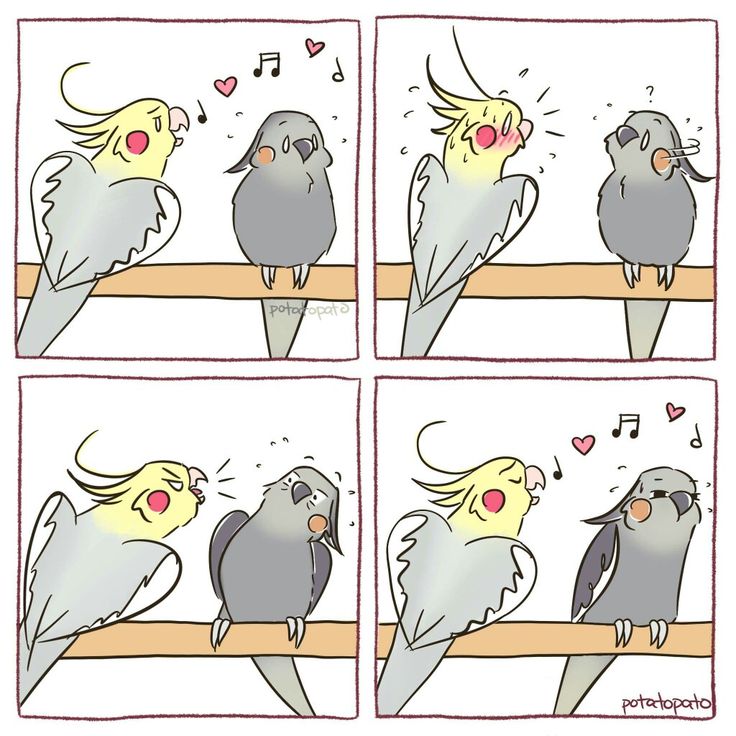
Special nail clippers, which have a rounded edge, should be used to trim the nails of your bird. Take care to only clip the tip of the nail, clipping too much will cause the toe to bleed. If the toe starts to bleed, Nebusulf powder which contains the antibiotic Neomycin, must immediately be applied to the wound.
Sexing Cockatiels
Both males and females look remarkably alike especially until they reach sexual maturity. One way to distinguish between the sexes is that the males sing and whistle while the females don’t. Males have bright orange patches on their cheeks, while females have duller patches. Another distinguishing aspect is that females have pale yellow/white dots on the underside of their wings and yellow/white barring on their tails. Males simply do not have this characteristic.
Cockatiels are not generally aggressive and have a good natured disposition. However, in the event that male cockatiels are kept together in a cage, there is a possibility of the dominant male pecking the more timid male, perhaps even preventing it from eating. The solution would be a larger cage with two food trays and two water trays. If however, the dominant male continues pecking the timid male, than separate the birds into different cages.
The solution would be a larger cage with two food trays and two water trays. If however, the dominant male continues pecking the timid male, than separate the birds into different cages.
Egg binding
Egg binding is a medical condition when a female bird is unable to expel an egg. Egg binding can pose a serious threat to cockatiels. Younger females are at a greater risk of dying from egg binding. In the event that a female cockatiel is suddenly puffed-up and listless, it is quite likely due to egg-binding.
The female must immediately be placed in a small cage or shoe-box and provided with additional warmth. A heating lamp would be ideal. Castor oil or even cooking oil can be gently applied in to the birds vent or cloaca, with a Q-tip (a cotton bud) to lubricate the area and facilitate the passing of the difficult egg. One drop of castor oil given orally will also help the passage of the egg. If these basic requirements are provided it is unlikely that the bird will suffer any serious health issues.
Breeding
Cages for breeding cockatiels should be an average size of 20”X20”X50”. The nest-box in the breeding cage should be 9”X11”X12” with a 2” opening. The nest-box can be mounted on the outside of the cage. Most cages now come equipped with a small door at the side of the cage which can be used as an entry to the nest-box. If on the other hand birds are housed in aviaries then the box can be placed inside the aviary itself. Nesting material should consist of pine shavings, shredded paper & freshly cut grass.
Cockatiels live for an average of 15-20 years in captivity and breed well in captivity. Males mature by 12 months of age while females mature by 18 months of age. When a female cockatiel is ready to mate she will sit low on a perch with her tail in the air while emitting a peeping sound while males will tap their beaks on the cage to gain the female’s attention. The eggs are laid a week after mating. The eggs hatch after a period of 21 days. Cockatiels usually lay a clutch of 4-8 eggs, twice a year.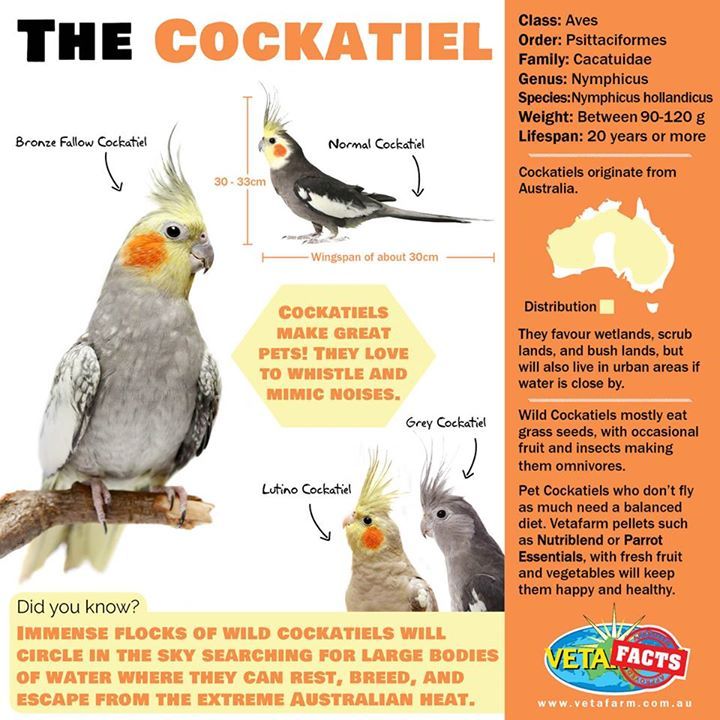
Freeing cockatiels
Freeing cockatiels is just not an option as they will surely be attacked and killed by other predatory birds such as hawks, kites, shikras, crows, etc. as they are vulnerable and unable to fend for themselves. They will also be vulnerable to other predators such as cats, snakes, rats, etc. unless they can find themselves a safe place to roost.
In the wild, cockatiels forage for grain (usually on farms), feed on grass seeds, leaves, vegetables and fruit. Locating such food sources, especially in environments they are not native, would be extremely difficult. Needleless to say, this would be even more difficult in a city.
References
Barrie, A. (1997) Guide to owning a cockatiel. T.F.H. Publications, New Jersey
Grindol, D. (1998) The complete book of cockatiels. Howell Book House, New York
Grindol, D. (2001) Cockatiels for dummies. For Dummies, New York
Mancini, J.R. and Haupt, T. (2008) Cockatiels (Complete pet owner’s manuel). 2nd Ed. Barrons Educational Series, New York
2nd Ed. Barrons Educational Series, New York
Photographs used
Lucy. Female cockatiel.
Available from:
http://www.cockatiel-birds.com/parrot/7055/female_cockatiel
[Accessed: 21/11/2011]
Corina Gardner. Bent spoon feeder.
Corina Gardner. Juvenile cockatiel.
Devna Arora. Disposable syringe feeder.
Brett Donald. Adult male.
Available from:
http://www.flickr.com/photos/bdonald/3032933616/
[Accessed: 23/11/2011]
Dylan Ashe. Feeding a baby cockatiel.
Available from: http://www.flickr.com/photos/ackook/page49/
[Accessed: 23/11/2011]
Dylan Ashe. New born cockatiel.
Available from: http://www.flickr.com/photos/ackook/page49/
[Accessed: 23/11/2011]
Dylan Ashe. 1 week old cockatiel. Available form:
http://www.flickr.com/photos/ackook/504676509/in/photostream
[Accessed: 23/11/2011]
Dylan Ashe. 3 weeks old cockatiel.
Available form: http://www.flickr.com/photos/ackook/page48/
[Accessed: 21/11/2011]
Dylan Ashe.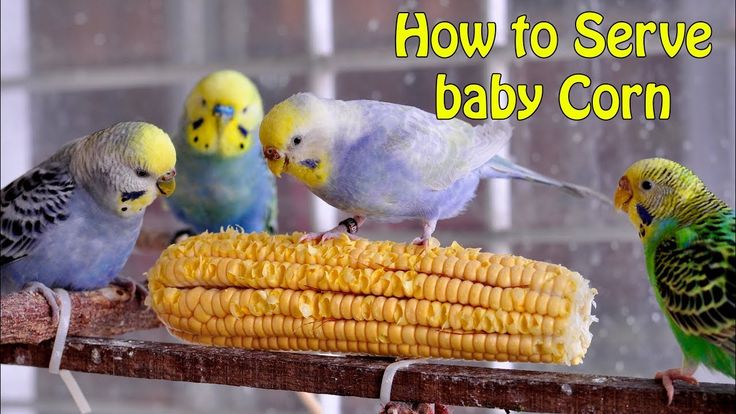 4 weeks old cockatiel.
4 weeks old cockatiel.
Available form: http://www.flickr.com/photos/ackook/page48/
[Accessed: 21/11/2011]
Dylan Ashe. 5 weeks old cockatiel.
Available form: http://www.flickr.com/photos/ackook/page47/
[Accessed: 21/11/2011]
Lianne. Enjoying a mist bath.
Available from: http://www.flickr.com/photos/ysaleth/2834585666/
[Accessed: 26/11/2011]
Matrixphere. Cockatiel bathing. Available from:
http://www.flickr.com/photos/matrixphere/73109842/
[Accessed: 26/11/2011]
Ulf Gotthardsson. Cockatiel foraging. Available from:
http://www.flickr.com/photos/ulfgotthardsson/2981225192/sizes/l/in/
set-72157608229228990/
[Accessed: 21/11/2011]
Further reading
Excellent photographs on the entire stage of cockatiel chick development by Dylan Ashe can be viewed through the following links
http://www.flickr.com/photos/ackook/page47/
http://www.flickr.com/photos/ackook/page48/
http://www.flickr.com/photos/ackook/page49/
Cockatiel Mist Bath by 3sugarbeans
http://www. youtube.com/watch?v=pA47Mpn05YQ
youtube.com/watch?v=pA47Mpn05YQ
Cockatiel Bath Time! by m4tt1600
http://www.youtube.com/watch?NR=1&v=kWCPDMHaeGU&feature=endscreen
Edited by Devna Arora
Published in 2011
Care For An Abandoned Baby Cockatiel
It can be a nerve-wracking experience to discover a newborn or very young cockatiel unexpectedly hatched out and abandoned by one or both parents. Once you are absolutely certain that a baby cockatiel is not being fed or consistently brooded and kept warm by its parents, you must act.
Baby birds that are well cared for have food in their crops — the little “sacks” under the throat located at the top of the breast. The parent birds pump food down the crop by grasping and shaking the baby bird’s beaks vigorously. Healthy youngsters scream for food and the adults first feed those that scream the loudest. Well-cared for baby birds are continuously brooded, nap contently between feedings, kept warm by their parents, and prevented from wondering away where they can grow cold and die.
In an ideal situation, aviculturists who raise cockatiels will attempt to find another pair of breeding birds with babies the same age so they can foster out the young. If the baby birds are too far apart in age, the foster parents might attack the newcomers, so it is critical that the babies’ ages are within days of one another.
However daunting at first, hand-feeding a single baby cockatiel can be successful providing you are fully committed from the start. Baby cockatiels require constant attention; if you are unable to be consistent or make the commitment, then you might have to find another solution.
When first hatched, a baby bird’s chance of survival during the first few days — especially with a new inexperienced hand-feeder — is very slim. Even experienced hand-feeders can lose babies that are under a week of age. This can be due to underdeveloped immune systems that would thrive better when fed by the baby bird’s parents, whose crop contents provide the natural flora and beneficial bacteria to ensure survival. Out of all the parrot species, the cockatiel is most sensitive to crop impaction. Crop impaction, or “sour crop,” is when the crop walls begin to slow down and digestion stops, leading to serious complications that are fatal if unattended.
Out of all the parrot species, the cockatiel is most sensitive to crop impaction. Crop impaction, or “sour crop,” is when the crop walls begin to slow down and digestion stops, leading to serious complications that are fatal if unattended.
Upon first discovering an unattended baby cockatiel, the most critical need to address is body temperature. Warming up the baby is not only essential to its overall survival, it is crucial to its ability to digest food. Never feed a cold baby! It is a guaranteed journey to an impacted crop.
Lacking a commercial brooder or incubator, home-made brooders can easily be built. Place a clean, empty aquarium or shoe box on top of a heating pad set to “medium” for a make-shift brooder. Towels can be partially draped to create more insulation if needed. Watch that baby birds do not become over-heated, or they can suffer heatstroke and die. Cockatiel babies that are too hot have gaping, wide-open beaks, while opening their tiny wings away from their bodies in an effort to keep cool.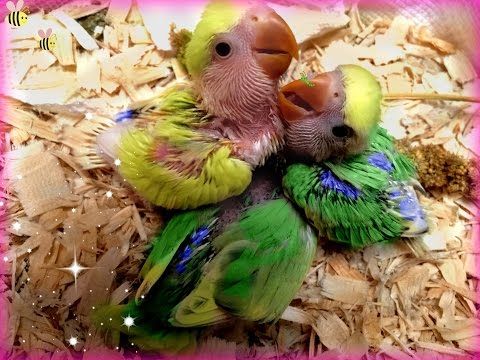 Baby birds that are too cold shiver, are restless, cry, and are unable to sleep. A thermometer is an excellent tool to keep track of temperature.
Baby birds that are too cold shiver, are restless, cry, and are unable to sleep. A thermometer is an excellent tool to keep track of temperature.
Babies between two and a half, to three weeks of age, may be kept in an environment between 92 and 94 degrees Fahrenheit. Gradually reduce the heat over time as the babies continue to feather, until reaching 86 degrees. At five to six weeks of age, move the babies into a cage so they may learn how to eat and perch; however, return them to the heated brooder at night to sleep. The babies will require another two or three weeks to wean and become completely self-sufficient. Gradually reduce the heat further over time, until they are weaned and sleeping comfortably on their own, and can remain full time in their new cage.
For single baby birds that have no siblings to cuddle with, a small paper cup stuffed with clean tissue paper provides superb support for drooping heads due to weak developing neck and can easily be changed with each feeding to keep the nest clean.
Fortunately, a variety of hand-feeding formulas are available today at local pet retailers that are ideal for hand-feeding baby cockatiels. Follow manufacturer’s instructions to the letter; each brand is different and prepared in a slightly different manner. Whichever brand you choose, always prepare fresh formula for each meal, discarding whatever is left over. Feeding leftover formula or formula that is not warm enough will impact a baby’s crop. Feeding formula that is too hot will scald the crop and cause serious, painful crop burn, requiring immediate veterinary emergency care for the baby bird to survive. Always test formula on the inside of your wrist — if it burns you, it will certainly burn the baby bird’s crop.
When attempting its first feed, you can try to drip a drop of formula onto the side of the baby bird’s beak; it will usually respond to the warmth and suck it in. If you lack a syringe, use a spoon with the sides curved upward. Another trick is to give a gentle “pinch” just like the parent grasping the baby bird’s beak. A baby usually responds by opening its beak, allowing you to slowly feed a small amount of food until it gets the idea to swallow. The chick will begin to vigorously pump its head up and down (at times almost too fast for the human eye!) hungrily taking in the formula.
A baby usually responds by opening its beak, allowing you to slowly feed a small amount of food until it gets the idea to swallow. The chick will begin to vigorously pump its head up and down (at times almost too fast for the human eye!) hungrily taking in the formula.
Be careful not to feed too quickly or to overfeed, which can cause a chick to aspirate the food back down its windpipe. If you need to re-warm formula during feedings, either prepare a new batch, or (if the manufacturer’s instructions allow) heat a small glass of hot water and place the container of formula within it to keep it warm.
It is always better to feed too loose a formula and feed more often until you and the baby can learn a schedule together. If fed too thick, a heavier formula can impact the crop. After feeds, clean the beak, face or other soiled feathers with a clean cloth or tissue. Dry, and return the baby bird to its warm environment immediately so it can digest its food. Sterilize all utensils and syringes in a good disinfectant, which is obtainable at a local animal hospital or hospital supplier.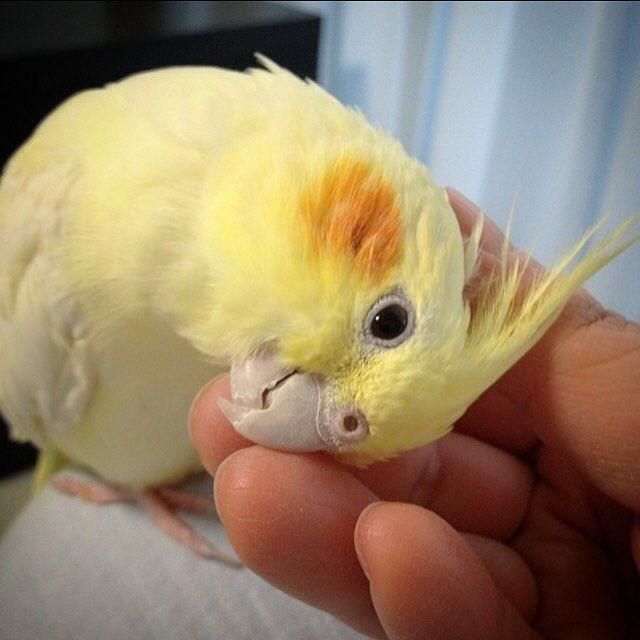
If a baby bird’s crop fills with air, massage is the correct treatment if you are able to gently burp the air out without aspirating the food up at the same time and risk the food going back down the windpipe. Frequent massages might be required. Air in the crop, however, is often a sign of further problems. If it does not resolve quickly, becomes worse or is accompanied by other problems, a veterinarian specializing in avian medicine should be sought.
For an avian veterinarian near your location, visit The Association of Avian Veterinarians. There is a listing for the public to find veterinarians whose practice includes birds, both within and outside the USA.
Newborns and tiny cockatiel babies require feeds at least every hour, then every two hours around the clock, with an eventual four-hour break at night near one week of age. Some cockatiel providers are able to arrange for more than one hand-feeder to take over at least part of the time, which greatly reduces the stress on the human caregiver. Most aviculturists will not “pull” baby birds for hand-feeding under 2 1/2 weeks of age, because baby birds require too many feeds each day. Waiting beyond 18 days can be tricky, because cockatiel babies are afraid of humans at that age and will often refuse food and be impossible to feed. Timing is everything!
Most aviculturists will not “pull” baby birds for hand-feeding under 2 1/2 weeks of age, because baby birds require too many feeds each day. Waiting beyond 18 days can be tricky, because cockatiel babies are afraid of humans at that age and will often refuse food and be impossible to feed. Timing is everything!
In the event that a parent cockatiel is interested in feeding, assisting or even brooding its young, it might be given the opportunity to do so. A close and careful watch is necessary to be certain the baby is properly cared for. Another option is to allow supervised visits, without chilling the baby or interrupting its digestion if it is on formula.
In general, 3-week old cockatiel babies usually require five feeds per day; 4-week old babies require four feeds; 5-week old babies need three feeds daily; 6-week old baby birds are usually down to two feeds per day; and 7 week-olds usually require only nightly feedings until they are weaned at 8 weeks of age.
Of course, this is an “ideal schedule” of averages and does not account for individuality, slow growers, early problems or special needs.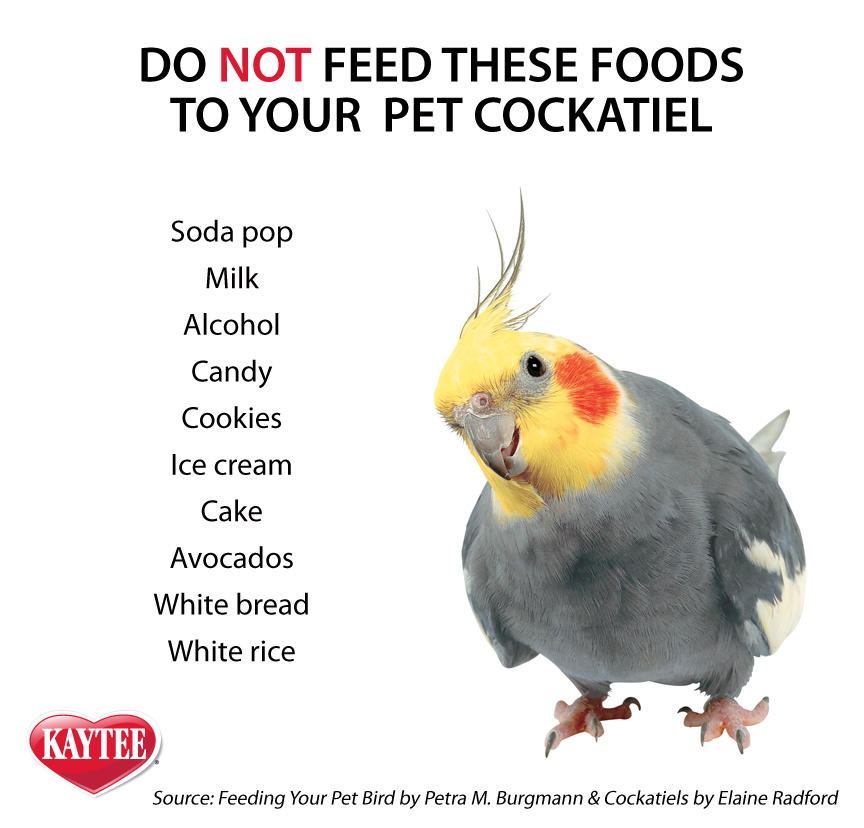 Some baby birds that start off slow easily catch up with maturity. Many aviculturists, the author included, have on occasion fed babies for one reason or another until it was 10 weeks of age. I’ve heard of longer, but that would usually point to other problems. However, never, ever, allow a cockatiel baby to go to bed hungry! If a baby bird’s crop is not full and round at bedtime, feed it you must. Weaning will occur when the cockatiel baby is developmentally ready to wean, and not before!
Some baby birds that start off slow easily catch up with maturity. Many aviculturists, the author included, have on occasion fed babies for one reason or another until it was 10 weeks of age. I’ve heard of longer, but that would usually point to other problems. However, never, ever, allow a cockatiel baby to go to bed hungry! If a baby bird’s crop is not full and round at bedtime, feed it you must. Weaning will occur when the cockatiel baby is developmentally ready to wean, and not before!
By 4 weeks of age, the “pin-cushion” you have been feeding will be fully feathered with a short little tail and can be kept in a larger aquarium or bird cage, protected from drafts, with food on the floor so it will learn to sample such dietary items. Tempting foods include millet spray; cockatiel bird food and fresh seed mix; stone ground whole-wheat bread; breakfast grains, such as shredded wheat or Cheerios; a corn, rice, and bean mix; corn on the cob; fresh, dark-green leafy vegetables, such as dandelion spinach, broccoli, parsley, carrots (including tops), among others; and other soft foods in moderation. Always supply clean drinking water, because cockatiel chicks wean faster when water is made available to them.
Always supply clean drinking water, because cockatiel chicks wean faster when water is made available to them.
Today, the mind-body connection in medical and health issues is more widely accepted. Similarly, the mental bond that can be established between a care-giver or hand-feeder and their charge can, and often does, pull an animal through to flourish successfully. The sheer power of devotion, connection and perseverance in the survival of a helpless baby that is dependent upon its caregiver can make all the difference in the world.
Posted by: Chewy Editorial
Featured Image: iStock.com/Cerenzio
Share:
Raising chicks. Corellas
Growing chicks. cockatielsWikiReading
Corellas
Nekrasova Irina Nikolaevna
Contents
Raising chicks
Cockatiel chicks are born bare and blind. They are covered with long yellow down.
They are covered with long yellow down.
During the first days after the chicks hatch, the female feeds them with a yellowish-white liquid, which many breeders call crop milk. However, in the literature, this protein-rich mass is called the milk of the anterior stomach. nine0003
Female with chick
When the last chick appears, the parrots are not permanently in the nest, but fly out from there in search of food.
After 3-4 days, the female begins to give her chicks solid food (the male feeds the female sitting in the nest box, and she passes the food to the chicks) - semi-digested grains. It is best at this time, along with the grain mixture, to feed the parrots with germinated seeds.
The sounds made by chicks when they are hungry differ at different times in their lives. Very small chicks shout "Tzik!" or “Ttzit!”, and already grown-ups “croak” or “snor”. nine0003
By this time you should increase your daily allowance of supplementary food and grain mixture, and it is also useful for parrots to give boiled crushed chicken eggs.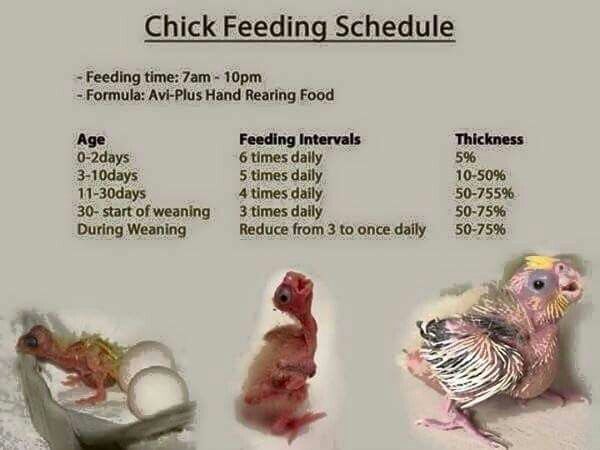 Many veterinarians do not recommend giving greens to birds during this period.
Many veterinarians do not recommend giving greens to birds during this period.
By the end of the 1st week, the eyes of the chicks open, and feather stumps begin to grow on the back and head. By the 11th-13th day, the chicks are completely covered with down, after which stumps of fly and tail feathers grow in them.
Only on the 16th-17th day, the flight feathers reach a significant size, and the chicks begin to become covered with stumps of covert feathers, becoming like small bristling hedgehogs. nine0003
Feathers on the back, head and wings appear in young parrots towards the end of the 3rd week of life. By the age of one month, the chicks are fully feathered. At the age of 35–40 days, the chicks leave the nest.
By this time, the chicks have already learned a lot. They can sit on a perch, take food, flap their wings. Some chicks are already trying to fly.
It happens that the female does not feed the chick in the first few hours after it hatches from the egg. You should not panic because of this: the chick has a certain reserve of nutrients in the yolk bladder, and it can live for several hours without receiving food. nine0003
You should not panic because of this: the chick has a certain reserve of nutrients in the yolk bladder, and it can live for several hours without receiving food. nine0003
If the female does not feed the chick even after 2–3 hours, this means that the parrot that has been born is either too weak to take food, or the instinct to feed the chicks has not worked in the female.
If you encounter this problem, move the chick to another nest containing newly hatched birds, or give the female a 4-5 day old chick from another nest to encourage her to feed with his squeak.
If this does not work, you can try to save the bird by artificial feeding. To do this, dilute the baby food (the mixture should be relatively liquid) and heat it to 35-37 ° C. Then take the chick in your hand, put it on its back, dip a small brush into the prepared mixture and bring a drop hanging from the end of the brush to the side of the parrot's beak. If the chick is not too weak, he will swallow a drop of food. Feed the chicks until full, every 2 hours (and at night too). nine0003
Feed the chicks until full, every 2 hours (and at night too). nine0003
From the 7th day of life, the chicks can be fed every 3 hours and only from 6-7 to 22 hours. Every day, the dose of food must be increased and, in addition, baby cereal mixture should be added to it.
Little chicks look defenseless
Corellas that have reached the age of 14 days are already much easier to feed. Millet porridge can be added to the usual food of 2-week-old parrots (millet should be crushed).
Starting from the 20-21st day of life, the chicks can be transplanted into a cage or a small cage and begin to learn to take food from a long spoon inserted through a net or an open door. nine0003
This text is an introductory fragment.
Nursing chicks
Feeding chicks The process of feeding chicks in budgerigars begins 17 days after the female has taken up incubation. Starting from this moment, the female should receive daily, in addition to the usual food, an egg mixture, greens, finely chopped
Starting from this moment, the female should receive daily, in addition to the usual food, an egg mixture, greens, finely chopped
Hypothermia (chicks hypothermia)
Hypothermia (hypothermia of chicks) As you know, in the first 30 days of life in birds, the thermoregulation system is imperfect and they need artificial heating. Under adverse conditions, especially when hypothermia, chicks gather near a heat source,
Hatchling period
nine0002 Hatching period for chicks In the finished nest, the female lays 4–6 white eggs, which then incubate for about 19–26 days. The bird warms the eggs with its body. In addition, twice a day she turns them over, constantly moving from side to side and from the center to the edge andChick-rearing period
Chick feeding period Chicks begin to emerge from eggs on the 19th-22nd day from the start of incubation. They are very helpless, slightly pubescent, almost naked, blind, with closed auditory canals. However, a few hours after hatching, they are already able to eat. nine0003
They are very helpless, slightly pubescent, almost naked, blind, with closed auditory canals. However, a few hours after hatching, they are already able to eat. nine0003
Cockatiel chick formula
Mixtures for feeding cockatiel chicks Mixture No. 1 Grated white crackers - 1.5 tablespoons, hard-boiled egg - 1 pc., Calcium gluconate - 2 tablets, glucose - 2 tablets, vitamin C - 1 dragee. Pound tablets and dragees to a powdery state, add grated
to themRemoval of chicks from parents
Removal of chicks from parents It is advisable to leave the chicks with their parents as long as possible. Usually cockatiels feed their chicks up to 2 months. But there are times when the female is preparing for the second clutch. In this case, the parents stop feeding the grown chicks. If it's
Diseases of chicks
Diseases of chicks Cockatiel chicks are more prone to various diseases and injuries than adult birds. To avoid the occurrence of infectious diseases, it is necessary to clean the breeding premises daily, thoroughly wash the feeders, drinkers, baths, perches, etc.
To avoid the occurrence of infectious diseases, it is necessary to clean the breeding premises daily, thoroughly wash the feeders, drinkers, baths, perches, etc.
Chick injuries
Chick injuries Parents often cause serious damage to chicks. For example, sometimes parrots pull feathers from chicks. As a rule, only one of the parents behaves this way, so you can try to remove the aggressive bird and leave the chicks to be raised
Feeding period for 1-2 week old chicks
nine0002 Feeding period for 1-2 week old chicks Mixture 1 Ingredients:> chicken eggs - 2 pcs.;> powdered milk formula with oatmeal for baby food - 1 tablespoon;> glucose - 3 tablets;> grated white crackers or semolina - 2 tablespoons;> calcium glycerophosphate orArtificial rearing of chicks
Artificial rearing of chicks If the bird actually refuses to feed the chicks from the very beginning, it is not very easy for an amateur to feed them, especially considering that in the first days after hatching, the chicks are usually fed with goiter milk, which is
Chicks appear
The appearance of chicks Canary chicks, as a rule, hatch from eggs on their own, without the help of a female. Their skin is covered with long sparse down (yellow, white, red and isabella chicks have pink skin and white down; green and gray canary chicks are born with dark
Their skin is covered with long sparse down (yellow, white, red and isabella chicks have pink skin and white down; green and gray canary chicks are born with dark
Nursing chicks
nine0002 Feeding chicks On the first day after birth, chicks are able to do without food, as they still have a certain supply of nutrients. But at the same time, all chicks without exception have an unconditioned beak opening reflex, whichCHICKEN DEVELOPMENT
CHICKEN DEVELOPMENT Chicks appear blind, covered with sparse filamentous down. Due to the lack of a constant body temperature in the first days of life, they need to be heated or protected from the scorching rays of the sun. The first hatched chick receives food from its parents after 4–6
CHICK FEEDING
FEEDING CHICKS The hatched chick is completely helpless, naked, barely covered with fluff and - in the first 7-8 days - blind.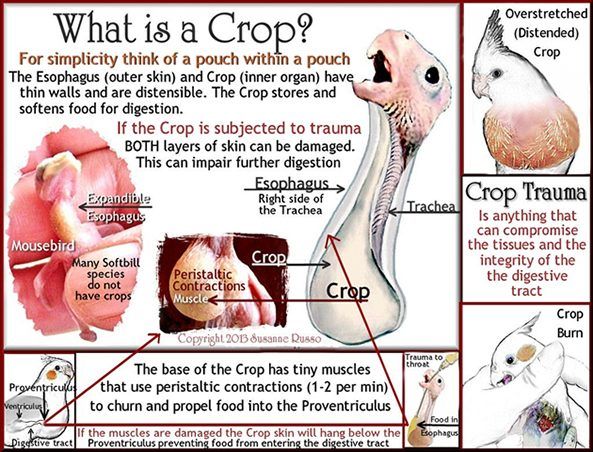 In a normally developed hatchling, the yolk sac should be fully retracted. Chicks with unretracted yolk sac usually
In a normally developed hatchling, the yolk sac should be fully retracted. Chicks with unretracted yolk sac usually
BATTLE FEEDING
nine0002 ARTIFICIAL FEEDING OF CHICKS The mass of the hatched chick is 13–18 g, after 2 days it is twice as much, and by the age of one month it reaches 260–380 g, depending on the breed. After hatching, the chick can live without food for about a day, after which it dies. Left in the nestNursing chicks
Feeding chicks Approximately 6 hours after hatching, “bird's milk” is formed in the goiter of the parents, with which they feed their brood during the first 10–12 days. The composition of goiter milk includes protein (10–19%), fat and fat-like substances (7-13%), minerals and
90,000 than you can feed the Corella parrot: Useful tipsContent
- 1 Useful food for the parrot
- 2 Corell
- 3 How to feed Corella
- 4 than feed the Corella parrot
- 5
- About the author
- Recent publications
Inna Grabovaya
Candidate of Veterinary Sciences, practicing veterinarian
Inna Grabovaya recently published (view all)
Corella parrots are very beautiful and can become a faithful friend of the owner for many years.
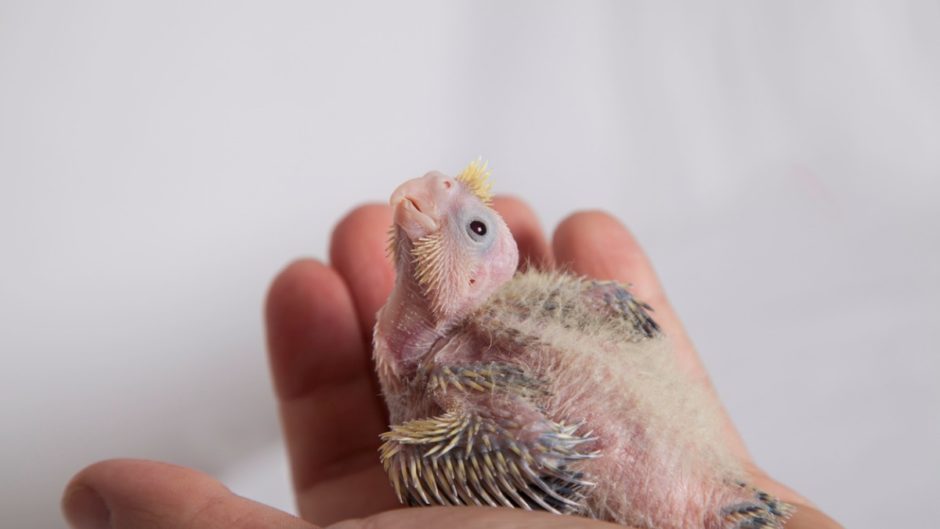 If you properly care for the bird and feed the parrot well, then the cockatiel will delight you with its company for at least 25 years (see How long cockatiels live).
If you properly care for the bird and feed the parrot well, then the cockatiel will delight you with its company for at least 25 years (see How long cockatiels live). Healthy parrot food
What to feed the cockatiel? - this question is asked by every caring owner. Let's try to figure it out.
A parrot native to Australia, these bright, elegant birds eat various fruits and seeds with an appetite, and, on occasion, are not averse to snacking on insects.
What to feed a cockatiel?
This question is best asked to the pet store clerk when buying a pet. The basis of your pet's diet should be different types of grains. Corella can be fed with a grain mixture, which should include the following cereals: millet (red millet should be preferred), millet (it is better to make thick porridge from millet), wheat (preferably sprouted), boiled oats. You need to give the parrot greens daily. nine0003
Cockatiel Food
There is a very simple and reliable way to check the quality of parrot food purchased in the store - you need to try to germinate a little grain mixture. If the grains germinated perfectly, then the mixture is of high quality and fresh, it will benefit your pet. If the grains do not want to germinate or germinate poorly, then such a mixture is stale or overripe, and it definitely will not add health to the bird.
Corella parrot: feeding
The most important task is to make the feeding of your pet as varied as possible. Chicory should be added to bird food at least twice a week, in season - young dandelion leaves, finely chopped carrot tops, nettles and celery. A wonderful spring treat for a parrot is swollen tree buds. You can pamper your pet with peeled sunflower seeds.
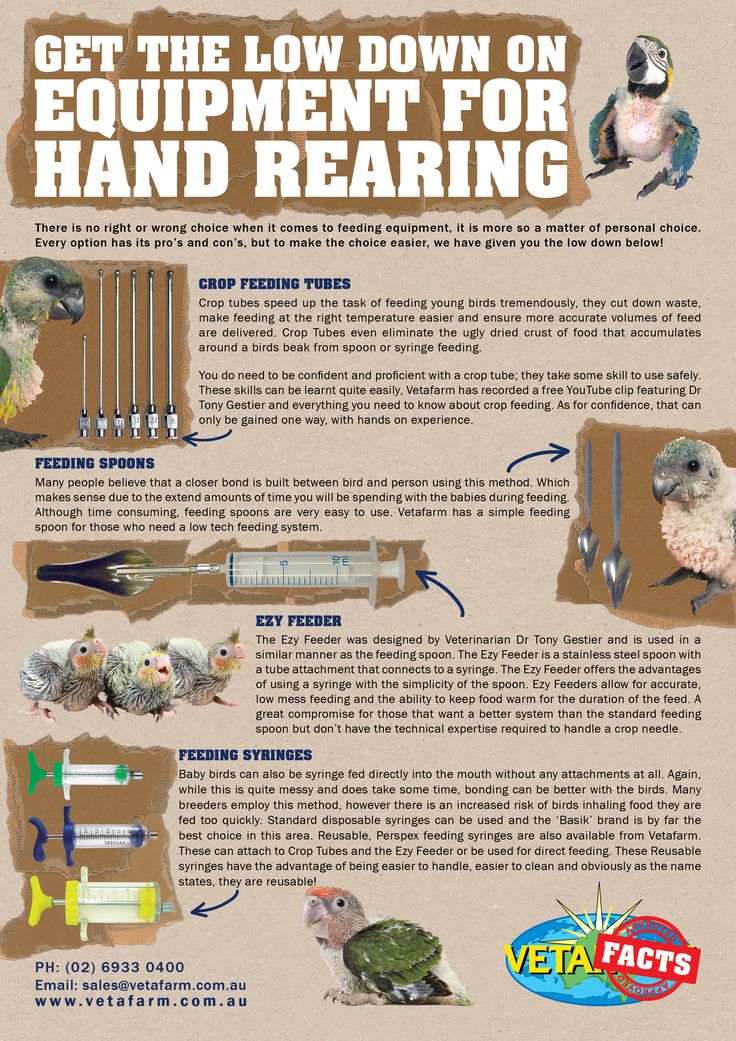
How to properly feed your cockatiel
In winter, you need to introduce canary seed into your pet's diet. Canary seed is quite expensive, but it contains all the minerals the bird needs, so in winter you need to give it at least every other day. You can give the parrot soft corn grains - as a rule, cockatiels love it very much, but it is better to cook porridge from dried corn grains. They are very fond of cockatiels and green peas, but this delicacy should not be given to parrots in large quantities, otherwise you will then have to treat the bird for diarrhea. nine0003
Feeding cockatiels: what you need to know
You can treat your pet with crushed nuts, finely chopped boiled eggs, crumbs of not too sweet cookies, crushed crackers, low-fat cottage cheese. You can offer the parrot a finely chopped apple, a piece of watermelon pulp, chopped bananas, oranges or kiwi. From vegetables, you can offer boiled carrots, pieces of zucchini, a juicy leaf of cabbage, pieces of beets.
 The bird must always have fresh water, so the water in the drinker must be changed twice a day. nine0003
The bird must always have fresh water, so the water in the drinker must be changed twice a day. nine0003 What can you feed your cockatiel
Occasionally, you can treat cherries, after removing the seeds from the berries, pieces of melon, peaches, nectarines or mangoes. You can give your pet crushed acorns or chestnuts once a week. For a parrot weakened after an illness, it is advisable to give boiled chicken liver once a week for a month, but in a small amount.
It is important to know: what not to feed cockatiels
Pets should not be given leftovers from their table, in addition, parrots should absolutely not eat anything fried (fried sunflower seeds, fried nuts and crackers under the strictest ban). Don't give chips to cockatiels. It is strictly forbidden to give milk and kefir to birds. nine0003
How to feed cockatiel chicks
When the eyes of the chicks erupt, they can already be fed with liquid porridge cooked from semolina with the addition of small oat flakes.
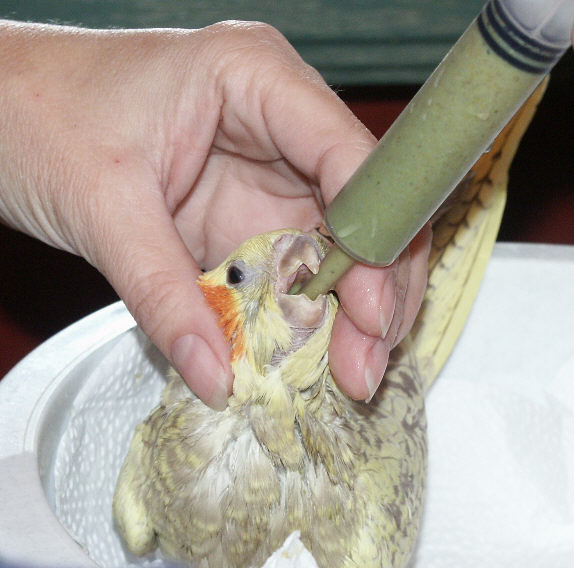 It is important that the porridge is warm, because the chicks will not eat either hot or cold food. After two weeks, you can already add a little millet to the porridge for babies. You can also give babies wheat flour, slightly diluted with water. You can feed the chicks with a mixture consisting of grated carrots, grated apple, wheat crackers, finely chopped eggs and sprouted wheat, taken in equal quantities. nine0003
It is important that the porridge is warm, because the chicks will not eat either hot or cold food. After two weeks, you can already add a little millet to the porridge for babies. You can also give babies wheat flour, slightly diluted with water. You can feed the chicks with a mixture consisting of grated carrots, grated apple, wheat crackers, finely chopped eggs and sprouted wheat, taken in equal quantities. nine0003 The diet of cockatiel chicks should include calcium gluconate and glucose. One tablet of calcium and one tablet of glucose are carefully ground, mixed with crushed crackers and given to the chicks.
Feeding cockatiel chicks
The first week the chicks should be fed every hour, the next week every two hours. Then for two weeks, the chicks should be fed every 3-4 hours. The main rule: chicks need to be fed in small portions, but often. Chicks in the first weeks of life are in great need of fresh water. A rich and varied diet, constant access to fresh water, and careful pet care will allow your cockatiel to delight you for many years.
